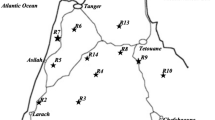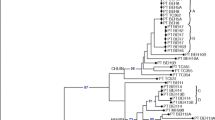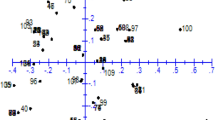Abstract
Traditional crops contribute to food security and agroecological sustainability, but their diversity is increasingly threatened by complex interplays of local and global sociocultural and economic change. Molecular markers are powerful tools to measure and characterize this diversity, and comparisons among different molecular marker systems are necessary to assess their appropriateness in different research contexts. Using a common sample set, we compare amplified fragment length polymorphism (AFLP) and microsatellite (simple sequence repeats; SSRs) techniques to assess their utility in research on the Andean tuber crop oca (Oxalis tuberosa Molina, Oxalidaceae). We find that 26 of 27 individuals have distinct AFLP genotypes, and all 27 individuals have distinct SSR genotypes. Both markers systems cluster samples in agreement with morphotype groups and separate clusters with similar strength, but more variation occurs within AFLP-based clusters than within SSR-based clusters. In addition, correlation between marker systems of pairwise distances is positive and significant (R = 0.831, p = 0.001). Ultimately, we discuss each system’s advantages and disadvantages for future oca diversity research.




Similar content being viewed by others
References
Alacs EA, Spencer PBS, Tores PJ, Krauss SL (2010) Population genetic structure of island and mainland populations of the quokka, Setonix brachyurus (Macropodidae): a comparison of AFLP and microsatellite markers. Conserv Genet 12:297–309
Albertini E, Porceddu A, Marconi G, Barcaccia G, Pallottini L, Falcinelli M (2003) Microsatellite-AFLP for genetic mapping of complex polyploids. Genome 46:824–832
Archak S, Gaikwad AB, Gautam D, Rao EVVB, Swamy KRM, Karihaloo JL (2003) Comparative assessment of DNA fingerprinting techniques (RAPD, ISSR and AFLP) for genetic analysis of cashew (Anacardium occidentale L.) accessions of India. Genome 46:362–369
Arnaud-Haond S, Duarte CM, Alberto F, Serrão EA (2007) Standardizing methods to address clonality in population studies. Mol Ecol 16:5115–5139
Bonnave M, Bleeckx G, Rojas Beltrán J, Maughan P, Flamand MC, Terrazas F, Bertin P (2014) Farmers’ unconscious incorporation of sexually-produced genotypes into the germplasm of a vegetatively-propagated crop (Oxalis tuberosa Mol.). Genet Resour Crop Evol 61:721–740
Bradbury, EJ (2014) Understanding toxic domesticates: biochemistry and population genetics of manioc (Manihot esculenta) and oca (Oxalis tuberosa). Ph.D. Dissertation, University of Wisconsin-Madison
Bradbury EJ, Emshwiller E (2011) The role of organic acids in the domestication of Oxalis tuberosa: a new model for studying domestication resulting in opposing crop phenotypes. Econ Bot 65:76–84
Campbell D, Duchesne P, Bernatchez L (2003) AFLP utility for population assignment studies: analytical investigation and empirical comparison with microsatellites. Mol Ecol 12:1979–1991
de Jesus ON, de Oliveira e Silva S, Amorim EP, Ferreira CF, de Campos JMS, de Gaspari Silva G, Figueira A (2013) Genetic diversity and population structure of Musa accessions in ex situ conservation. BMC Plant Biol 13:41
Dyer AT, Leonard KJ (2000) Contamination, error, and nonspecific molecular tools. Phytopathology 90:565–567
Elias M, Mühlen GS, McKey D, Roa AC, Tohme J (2004) Genetic diversity of traditional South American landraces of manioc (Manihot esculenta Crantz): an analysis using microsatellites. Econ Bot 58:242–256
Ellegren H (2000) Microsatellite mutations in the germline: implications for evolutionary inference. Trends Genet 16:551–558
Ellegren H (2004) Microsatellites: simple sequences with complex evolution. Nat Rev Genet 5:435–445
Emanuelli F, Lorenzi S, Grzeskowiak L et al (2013) Genetic diversity and population structure assessed by SSR and SNP markers in a large germplasm collection of grape. BMC Plant Biol 13:1
Emshwiller E (2002) Ploidy levels among species of the “Oxalis tuberosa alliance” as inferred by flow cytometry. Ann Bot 89(6):741–753
Emshwiller E (2006) Evolution and conservation of clonally propagated crops. In: Motley J, Zerega N, Cross HB (eds) Darwin’s harvest: new approaches to the origins, evolution, and conservation of crops. Columbia University Press, New York, pp 308–332
Emshwiller E, Theim T, Grau A, Nina V, Terrazas F (2009) Origins of domestication and polyploidy in oca (Oxalis tuberosa; Oxalidaceae). 3. AFLP data of oca and four wild, tuber-bearing taxa. Am J Bot 96:1839–1848
Excoffier L, Smouse PE, Quattro JM (1992) Analysis of molecular variance inferred from metric distances among DNA haplotypes: application to human mitochondrial DNA restriction data. Genetics 131:474–491
Gavrilenko T, Antonova O, Shuvalova A, Krylova E, Alpatyeva N, Spooner DM, Novikova L (2013) Genetic diversity and origin of cultivated potatoes based on plastid microsatellite polymorphism. Genet Resour Crop Evol 60:1997–2015
Goslee SC, Urban DL (2007) The ecodist package for dissimilarity-based analysis of ecological data. J Stat Softw 22:1–19
Guaraguara KJ (2013) Establecimiento de un kit de microsatelites en oca (Oxalis tuberosa Molina) para estudios de diversidad genética. M. Sc. Thesis. Universidad Mayor de San Simón, Cochabamba, Bolivia, 133 p
Guichoux E, Lagache L, Wagner S, Chaumeil P, Léger P, Lepais O et al (2011) Current trends in microsatellite genotyping. Mol Ecol Resour 11:591–611
Hermann M (1992) Raíces y tubérculos andinos: prioridades de investigación para un recurso alimentario pospuesto. International Potato Center, Lima
Jarvis DI, Padoch C, Cooper HD (2007) Biodiversity, agriculture, and ecosystem services. In: Jarvis DI, Padoch C, Cooper HD (eds) Managing biodiversity in agricultural ecosystems. Bioversity International, New York, pp 1–12
Jarvis DI, Brown ADH, Cuong PH, Collado-Panduro L, Latournerie-Moreno L, Gyawali S, Tanto T et al (2008) A global perspective of the richness and evenness of traditional crop-variety diversity maintained by farming communities. Proc Natl Acad Sci 105:5326–5331
Johns T (2003) Plant biodiversity and malnutrition: simple solutions to complex problems. Afr J Food Agric Nutr Dev 3:45–52
Kardolus JP, van Eck HJ, van den Berg RG (1998) The potential of AFLPs in biosystematics: a first application in Solanum taxonomy (Solanaceae). Plant Syst Evol 210:87–103
Kuchma O, Vornam B, Finkeldey R (2011) Mutation rates in Scots pine (Pinus sylvestris L.) from the chernobyl exclusion zone evaluated with amplified fragment-length polymorphisms (AFLPs) and microsatellite markers. Mutat Res 725:29–35
Malice M, Martin N, Pissard A, Rojas-Beltran JA, Gandarillas A, Bertin P, Baudoin JP (2007) A preliminary study of the genetic diversity of Bolivian oca (Oxalis tuberosa Mol.) varieties maintained in situ and ex situ through the utilization of ISSR molecular markers. Genet Resour Crop Evol 54:685–690
Malice M, Bizoux JP, Blas R, Baudoin JP (2010) Genetic diversity of Andean tuber crop species in the in situ microcenter of Huanuco, Peru. Crop Sci 50:1915–1923
Mantel N (1967) The detection of disease clustering and a generalized regression approach. Cancer Res 27:209–220
Mariette S, Chagné D, Lézier C, Pastuszka P, Raffin A, Plomion C, Kremer A (2001) Genetic diversity within and among Pinus pinaster populations: comparison between AFLP and microsatellite markers. Heredity 86:469–479
Mariette S, Le Corre V, Austerlitz F, Kremer A (2002) Sampling within the genome for measuring within-population diversity: trade-offs between markers. Mol Ecol 11:1145–1156
Marker Technologies (2013) http://www.wageningenur.nl/en/Expertise-Services/Statutory-research-tasks/Centre-for-Genetic-Resources-the-Netherlands-1/Centre-for-Genetic-Resources-the-Netherlands-1/Expertise-areas/Plant-Genetic-Resources/Research-at-CGN/Molecular-markers/Marker-technologies.htm. Accessed 1 Dec 2013
Mkumbira J, Chiwona-Karltun L, Lagercrantz U, Mahungu NM, Saka J, Mhone A et al (2003) Classification of manioc into ‘bitter’ and ‘cool’ in Malawi: from farmers’ perception to characterisation by molecular markers. Euphytica 132:7–22
Peakall R, Smouse PE (2006) Genalex 6: genetic analysis in excel. Population genetic software for teaching and research. Mol Ecol Notes 6:288–295
Pejic I, Ajmone-Marsan P, Morgante M, Kozumplick V, Castiglioni P, Taramino G, Motto M (1998) Comparative analysis of genetic similarity among maize inbred lines detected by RFLPs, RAPDs, SSRs, and AFLPs. Theor Appl Genet 97:1248–1255
Pfeiffer T, Roschanski AM, Pannell JR, Korbecka G, Schnittler M (2011) Characterization of microsatellite loci and reliable genotyping in a polyploid plant, Mercurialis perennis (Euphorbiaceae). J Hered 102:479–488
Pissard A, Ghislain M, Bertin P (2006) Genetic diversity of the Andean tuber-bearing species, oca (Oxalis tuberosa Mol.), investigated by inter-simple sequence repeats. Genome 49:8–16
Pissard A, Arbizu C, Ghislain M, Faux AM, Paulet S, Bertin P (2007a) Congruence between morphological and molecular markers inferred from the analysis of the intra-morphotype genetic diversity and the spatial structure of Oxalis tuberosa Mol. Genetica 132:71–85
Pissard A, Rojas-Beltran JA, Faux A-M, Paulet S, Bertin P (2007b) Evidence of intra-varietal genetic variability in the vegetatively propagated crop oca (Oxalis tuberosa Mol.) in the Andean traditional farming system. Plant Syst Evol 270:59–74
Russell JR, Fuller JD, Macaulay M, Hatz BG, Jahoor A, Powell W, Waugh R (1997) Direct comparison of levels of genetic variation among barley accessions detected by RFLPs, AFLPs, SSRs and RAPDs. Theor Appl Genet 95:714–722
Skrede I, Borgen L, Brochmann C (2009) Genetic structuring in three closely related circumpolar plant species: AFLP versus microsatellite markers and high-arctic versus arctic–alpine distributions. Heredity 102:293–302
Turumaya AA (2011) Desarrollo de marcadores microsatélites para la caracterización de germoplasma en oca (Oxalis tuberosa Molina). M. Sc. Thesis. Universidad Mayor de San Simón, Cochabamba, Bolivia, p 71
Veasey EA, Borges A, Rosa MS, Queiroz-Silva JR, de Andrade Bressan E, Peroni N (2008) Genetic diversity in Brazilian sweet potato (Ipomoea batatas (L.) Lam., Solanales, Convolvulaceae) landraces assessed with microsatellite markers. Genet Mol Biol 31:725–733
Vos P, Hogers R, Bleeker M, Reijans M, van de Lee T, Hornes M, Frijters A, Pot J, Peleman J, Kuiper M, Zabeau M (1995) AFLP: a new technique for DNA fingerprinting. Nucleic Acids Res 23:4407–4414
Zeven AC (1980) Polyploidy and plant domestication: the origin and survival of polyploids in cytotype mixtures. In: Lewis WH (ed) Polyploidy: biological relevance. Plenum Press, New York, pp 385–407
Acknowledgments
The authors would like to thank Cécile Ané, Bret Larget, and Rebecca Shirk (UW-Madison) for help with statistical analyses and Sarah Friedrich for help with figures. EE thanks the people and community authorities of the Communities Amaru, Sacaca, and Viacha; INRENA for collection permits for Peru in 1996–1997; and funding from a Student Fulbright Research Grant, and National Science Foundation (USA) Doctoral Dissertation Improvement Grant #DEB9623227 to Jeff J. Doyle and EE.
Author information
Authors and Affiliations
Corresponding author
Rights and permissions
About this article
Cite this article
Moscoe, L.J., Emshwiller, E. Diversity of Oxalis tuberosa Molina: a comparison between AFLP and microsatellite markers. Genet Resour Crop Evol 62, 335–347 (2015). https://doi.org/10.1007/s10722-014-0154-x
Received:
Accepted:
Published:
Issue Date:
DOI: https://doi.org/10.1007/s10722-014-0154-x




